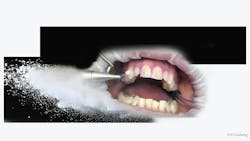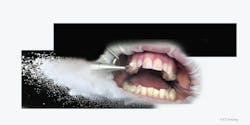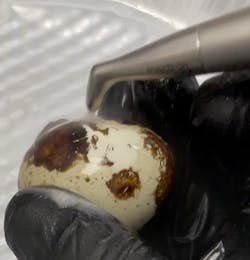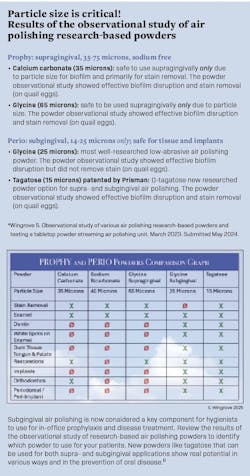Definitive guide to new research-based powders for air polishing
What you'll learn in this article
-
Key differences between traditional and new research-based air polishing powders, including safety considerations and clinical indications
-
How to evaluate powder streaming units for clinician comfort, patient safety, and ease of maintenance
-
Clinical insights from an observational study comparing leading supragingival and subgingival powders, including a new prebiotic option
Powder streaming using an air polishing device (figure 1) is fast becoming the method of choice to disrupt biofilm, for biofilm management maintenance, and for doctors to use to decontaminate the oral cavity prior to surgical procedures. It is effective on natural teeth, dental implants, restorations, and orthodontic appliances. Also, it is an important step to use in periodontal and peri-implant disease treatments to decrease inflammation and bleeding caused by host response to bacteria and oral pathogens.
The 2008 European Workshop on Periodontology’s sixth workshop consensus report recommended “the clinical application of air polishing for the management of peri-implant mucositis and peri-implantitis.”1-2 Results show clinical improvements, such as reduction in bleeding on probing and effective biofilm disruption. The American College of Prosthodontists also recommended in their Clinical Practice Guidelines for Recall and Maintenance of Patients with Tooth-Borne and Implant-Borne Dental Restorations to “use powered instruments such as glycine powder air polishing system” to disrupt biofilm.3 Air polishers have shown great results in biofilm management—not intended to remove calculus but as an adjunct to ultrasonics and hand instrumentation.4
Multiple powder streaming air polishing devices are available for use but should not be confused with using a Prophy-Jet. The Prophy-Jet, by Dentsply, was the original device designed to be used at 43-58 psi for supragingival stain removal with sodium bicarbonate (40 micron) powder. Following the research today, traditional Prophy-Jets with sodium bicarbonate powder are contraindicated for patients with multiple medical conditions, supragingivally on patients with restorations, and subgingivally around implants.
Fast forward to the new powder streaming devices that are safe to use with the proper powder supragingivally or subgingivally according to particle size. We completed an observational study in March 2023 and submitted it in May 2024. The objectives were to test a new air polishing unit, COMBI touch by Mectron Dental (stand-alone air polisher and piezo), with three principal research-based powders and a promising new fourth powder from Prisman GmbH.
Objectives for the air polishing unit evaluation were to report on all attributes, ease of set-up, how the unit performed with the powders, and how the unit compared with other units on the market. We tested how easily the handpiece could be used by clinicians and how comfortable the tips were for patients. We also aimed to answer the question: How much maintenance will be required to start up each day, in between patients, and at end of day?
Choosing a powder streaming unit
For this article, I focused on evaluating what to look for in a stand-alone powder streaming unit, not handheld devices. Identifying key benefits for clinicians, patients, and low maintenance was the goal.
Clinician comfort and access for effective air polishing:
- Are the handpieces a good fit, balanced, and not too bulky?
- Can the clinician use the handpieces to access posterior dentition and patients with restricted opening issues?
- Is the subgingival tip thin and flexible enough to use especially in the sulcus of natural teeth and implants, and most importantly, is it comfortable for the patient?
Maintenance:
- Is the unit easy to set up to the air and water in the operatory?
- At the end of the day, how much maintenance is required for the clinician?
- Does the powder reservoir, bottle, or handpiece become clogged?
Benefits and features to look for in a tabletop unit
Flush cycle: unit includes a flush cycle for use between patients, at the end of day, and at the start of the next day of patient care with a push button
Powder containers: unit has multiple powder containers or the ability to switch powder containers easily and refill easily
Handpieces: balanced and designed to use around all types of dentitions and restorations
Subgingival tips: thin, flexible, and easy to place in the sulcus and around implants. Most importantly, is it comfortable for the patient?
Powders to use in air polishers are ever evolving. Research shows that powders can be 35-65 microns or larger for supragingival powders. Powders need to be 25 microns or less to be used subgingivally in the patient’s sulcus. Anything higher or larger in particle size can be damaging to the tissue, dentin, cementum, exposed root surface, and implants.
Air polishing powder options
Powder options available to use in this era of powder streaming air polishers:
Glycine (25-65 microns) is the most well-researched powder used in air polishing. It is a nonessential amino acid, low abrasive powder, and in appropriate amounts deemed safe for everyone. Glycine is available in a 65-micron powder for supragingival biofilm and stain removal. The most researched 25-micron glycine powder for subgingival biofilm removal is not intended for stain removal.
The 25-micron glycine powder has proven to be an effective alternative to previous air polishing powders without the risk of harming oral tissues, dentin, or cementum. Glycine 25-micron air polishing powder can be safely used on restorative materials, dental implants, debridement of periodontal pockets up to 5 mm, and studies support better nonsurgical periodontal disease therapy outcomes.
Sodium bicarbonate (40 microns) white powder, water-soluble salt is one of the original air polishing powders developed for supragingival stain removal. However, due to its particle size, it is contraindicated for subgingival air polishing. It is also not recommended for use on patients with veneers, crowns and bridges, implants, and lab-created prostheses with light-cured glazes (i.e., fixed, full-arch implant prostheses).
Based on various research studies, sodium bicarbonate has medical contraindications. It should not be used on patients with a sodium-restricted diet, hypertension, respiratory illness, infectious disease, renal insufficiency, Addison’s disease and Cushing’s syndrome, metabolic alkalosis, or on patients who are taking medications such as mineral corticoid steroids, antidiuretics, or potassium supplements.5 Research has shown that air polishing using sodium bicarbonate could lead to root structure loss and, therefore, is not recommended for exposed root surfaces or periodontal disease patients with a high incidence of gingival recession. Although many clinicians still use sodium bicarbonate powder, be sure you are aware of all the restrictions, or choose another, safer, option that attains the same results.
Calcium carbonate (35 microns) powder is a mineral found in rocks, eggshells, and seashells. It is a less abrasive supragingival powder primarily used to remove stains above the gumline. Calcium carbonate powder is gentle on enamel, sensitive teeth, restorations, and cleaning around orthodontic brackets. Most importantly, it does not have medical contraindications. It is efficient in achieving stain removal results, suitable for patients on salt-restricted diets, and a good alternative powder to the other contraindications of sodium bicarbonate powder.
Erythritol (14-15 microns) is a natural low-calorie sweetener (sugar alcohol) that is chemically classified as a polyol. It is used for supragingival and subgingival air polishing for biofilm management. Erythritol is exclusively used in EMS AirFlow Max and PerioFlow with plenty of water as stated in the instructions for use. Erythritol-based AirFlow Plus Powder can reduce counts of Streptococcus mutans in saliva and dental plaque and reduce the risk for dental caries. Erythritol is effective for biofilm disruption but not tested for stain removal in the March 2023 observational powder study.
Tagatose (15 microns), a new powder, is a noncariogenic monosaccharide (simple sugar) that is chemically classified as a ketose with an extremely low glycemic index, which makes it ideal for diabetic patients. Use tagatose for supra- and subgingival air polishing as it is less abrasive on tooth and root surfaces of natural teeth. It is safe for use around implants.
The newly developed, patented D-tagatose product by Prisman has been shown to selectively inhibit growth of the oral pathogens S. mutans and S. gordonii. Tagatose is abundant in the saliva of individuals with good oral health and reduces the number of aerobic and anaerobic bacteria in saliva. D-tagatose has “the potential as an oral prebiotic for its ability to manipulate the metabolism of targeted oral streptococci.”6 It has a pleasant taste for patients and does not demonstrate laxative results when ingested. Clinicians will appreciate the noncaking of this powder when used in a powder streaming air polisher. D-tagatose is a fast, effective biofilm remover with exceptional polishing performance.
Observational study on research-based powders
For our powder observational study, we limited testing to the top research-based powders: supragingival powders tested were calcium carbonate with a 35-micron particle size and glycine 65-micron powder for prophylaxis, stain removal, and after orthodontic bracket removal. Subgingival powders tested were glycine 25-micron particle size and new powder tagatose 15-micron particle size. We divided the powders into two categories: prophy—supragingival above the gum tissue, 35-65 microns and sodium-free powders; and perio—subgingival below the gumline, 14-25 microns only.
We tested each powder for spray through the handpieces, clogging, and stain removal using quail eggs (figure 2). All powders demonstrated easy handling in the tabletop unit. The handpieces sprayed effectively, with no clogging issues. See stain removal results in the results box from the observational study and the prophy/perio powders comparison chart (see sidebar) for choosing a powder to use for specific patients.
Note: check air polishing manufacturing instructions on which powders the unit and handpieces have been tested.
Editor's note: This article appeared in the October 2025 print edition of RDH magazine. Dental hygienists in North America are eligible for a complimentary print subscription. Sign up here.
References
- Lindhe J, Meyle J, Group D of European Workshop on Periodontology. Peri-implant diseases; consensus report of the Sixth European Workshop on Periodontology. J Clin Periodontol. 2008;35(8 Suppl):282-285. doi:10.1111/j.1600-051X.2008.01283.x
- Klinge B, Meyle J, Working Group 2. Peri-implant tissue destruction. The Third EAO Consensus Conference 2012. Clin Oral Implants Res. 2012;23(6 Suppl):106-110. doi:10.1111/j.1600-0501.2012.02555.x
- Bidra AS, Daubert DM, Garcia LT, et al. Clinical practice guidelines for recall and maintenance of patients with tooth-borne and implant-borne dental restorations. J Prosthodont. 2016;25(25 Suppl):S32-S40. doi:10.1111/jopr.12416
- Moëne R, Décaillet F, Andersen E, Mombelli A. Subgingival plaque removal using a new air-polishing device. J Periodontol. 2010;81(1):79-88. doi:10.1902/jop.2009.090394
- American Dental Hygienists’ Association Position Paper on Polishing. American Dental Hygienists Association. Accessed 2010. adha.org/resources-docs/7115_Prophylaxis_Position_Paper.pdf
- Mayumi S, Kuboniwa M, Sakanaka A, et al. Potential of prebiotic D-tagatose for prevention of oral disease. Front Cell Infect Microbiol. 2021;11:767944. doi:10.3389/fcimb.2021.767944
About the Author

Susan S. Wingrove, BS, RDH
Susan is a dynamic innovator, writer, and international speaker. She is a highly skilled researcher, contributor to multiple product developments, and instrument codesigner of the Wingrove Titanium Implant Series, ACE probes, and Queen of Hearts instruments for PDT, Inc. Susan specializes in providing presentations, webinars, and workshops on protocols that follow the science for healthy teeth, implants, and disease treatment. She has written a textbook titled Peri-Implant Therapy for the Dental Hygienist: 2nd Edition.



